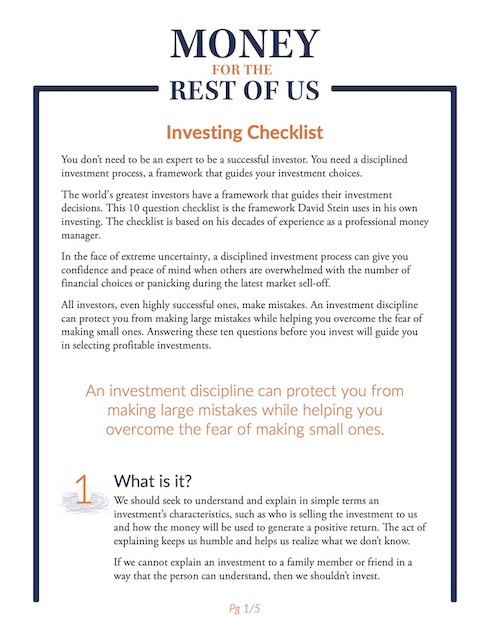David shares how his investing has changed over the past ten years and lessons you can apply to your portfolio.

Here are the ten lessons:
- Document Your Journey
- Keep Experimenting
- Be Willing to Adopt New Asset Classes
- Be Very Patient
- Trade Less, Focus On Long-term Drivers
- Monetary Diversification
- Don’t Focus on Relative Performance
- Ignore the Noise
- Take Your Time
- There Is No Right Way to Invest
Show Notes
The Investor Podcast 668: What I Learned About Investing w/ Stig Brodersen
Episode Sponsors
Delete Me – Use code David20 to get 20% off
Related Episodes
454: How To Invest – Ten Rules of Thumb for Individual Investors
423: A “Safe” 6% Yield: The Case for Investment Grade CLOs
372: When Should You Sell An Investment?
Transcript
Welcome to Money for the Rest of Us. This is a personal finance show on money, how it works, how to invest it, and how to live without worrying about it. I’m your host, David Stein. Today is episode 498. It’s titled, “What I Have Learned About Investing in the Past Decade.”
Last week, my friend Stig Brodersen of the Investors Podcast Network released an episode on 10 things he has learned about investing in the past decade since he launched TIP with Preston Pysh back in 2014. I’ve known Stig since 2017, we talk about every six weeks or so. His investment approach is very different than mine. And I encourage you to listen to that episode, as I’ve found it quite enlightening.
Money for the Rest of Us is also a decade old this year, and after listening to Stig’s episode, it got me thinking, “What have I learned about investing in the past decade?” I stepped down as chief investment strategist and chief portfolio strategist at my former investment advisory firm, FEG Advisors, in 2012. I worked there 17 years, including almost a decade managing close to $2 billion of discretionary assets. After leaving FEG, I knew I no longer wanted to manage assets for others, but I wanted to continue teaching about investing.
Auditing Track Records
Given my institutional investing background, I decided to get my track record for my personal portfolio verified by an accounting firm, Ashland Partners, which does independent verification of global investment performance standards, known as GIPS.
Now, I don’t know if they’ve ever verified the track record of an individual. Typically, it would be the investment composite for an asset manager. But I went ahead and did it; it was my individual retirement account. I calculated the performance, I sent them the calculations, they said “Yeah, those are correct. You can say they’re audited or verified now.”
The performance for the four-and-a-half years ending August 2012 was around 9.9% annualized, compared to 5% for the S&P 500, 1.9% for the MSCI All-Country World Index, and 6.7% for the Bloomberg Barclays Aggregate Bond Index. So performance was good. It was a fairly straightforward portfolio at the time. Only eight holdings. All ETFs. It was overweight US, with the largest holding being the PowerShares FTSE RAF US 1000 ETF.
I owned the Vanguard Dividend Appreciation ETF, (VIG). The ticker for the PowerShares’ ETF is PRF. I owned some US mid-cap, US small-cap, emerging markets. I own the Barclays Aggregate via the ETF AGG, some investment grade corporate bonds, and emerging markets bonds. That was it at the time.
My portfolio today is very different. Instead of eight holdings, I have over 50. Instead of most of my assets being public markets, now about half of my investment assets are private. Instead of just two asset classes, stocks, and bonds, I have over a dozen.
My portfolio objective is also different. Back then, my focus was primarily on growth, continuing to grow the portfolio. Now, having left the advisory profession, starting Money for the Rest of Us, my focus is on capital preservation; making sure my net worth maintains its real purchasing power after deducting spending and inflation.
Now, that 2012 portfolio, had I just kept that, it would have done well. About 5.5% annualized since August 2012, compared to roughly 40-60 global stocks, bonds returning 4.4% annualized since August 2012. We can use VT, Vanguard Total World Stock ETF as a proxy for stocks, 8.2% annualized since 2012. Bonds—negative 1.1% annualized.
Now, what’s done much better than that—if I had just stuck with the S&P, it’s done 14.7% annualized since 2012, and we’ll talk about that.
My portfolio is different. How I invest is different than I did a decade ago. So let’s look at 10 things I’ve learned investing in the past decade.
As a Money For the Rest of Us Plus member, you are able to listen to the podcast in an ad-free format and have access to the written transcript for each week’s episode. For listeners with hearing or other impairments that would like access to transcripts please send an email to team@moneyfortherestofus.com Learn More About Plus Membership »
